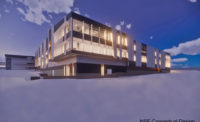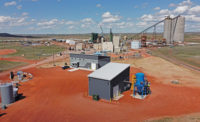When the COVID-19 pandemic brought air travel to a near stop in March, construction managers building the replacement terminal for Salt Lake City International Airport saw both a challenge and an opportunity. The challenge was keeping the workforce of up to 1,800 people healthy and on the job in the face of a global pandemic, while the dramatic drop in airport traffic presented an opportunity to complete all phases of the $4.1-billion facility more than two years ahead of schedule.
The 3.2-million-sq-ft replacement facility, a new five-level parking structure and central utility plant have been rising on a 296.7-acre site directly southwest of the current airport.
Bill Wyatt, the airport’s executive director, says the goal was to keep at least 65 gates open during construction. “As the pandemic hit and air traffic dropped off, it became apparent that keeping so many gates open while we worked on the second phase was not as critical as it had been just a few months ago,” he says.
“We presented the idea that we could begin tearing down all of the existing airport once we fully open in October. We’ll still have enough flexibility so that if demand returns sooner than we anticipate, we can do hard-stand boarding [transporting passengers to gates by bus]. We estimate this will move us to completion in 2024 and could save around $300 million.”
Program director Mike Williams says: “We recognized early (in the pandemic) that we needed new processes and procedures in place to keep going. The Salt Lake County Health Department people came out and were happy with what we were doing.”
But around the first week of July, Williams says workers or their associates began testing positive for the virus, in keeping with a statewide increase. “Someone would test positive or someone they were close with had a positive test, so not only would they have to leave the site, but people on the crew they had worked closely with would have to go too. We went from seven people who had to be off site to a peak of 88.”
Williams says quarantined and medically cleared workers continue to return to the job, and there has been increased vigilance on maintaining distance and cleaning. “When the numbers started going up, I think we were able to get our arms around the situation early and keep it from getting worse,” Williams says.
Wyatt and Williams say the first phase of the airport is still scheduled to open Sept. 15, with more concourses opening in October. Work is currently underway on art installations and preparing tenant spaces for occupancy.
— By Brian Fryer in Utah
Consulting Engineers Open Denver Office
International engineering firm Walter P Moore has opened a Denver office, its 21st location in the U.S., and appointed Bart Miller as managing director for the firm’s structures group. Miller brings nearly 20 years of coast-to-coast project experience, with a strong focus in sports and entertainment markets. The group encompasses the integrated design services of structural engineering, enclosure engineering, construction engineering, secure design and parking consulting. The Denver office officially opened on Aug. 1.
Denver Water’s New Building Employs Innovative Water Reuse
Denver Water recently opened its six-story, 186,000-sq-ft administration building, the focus of its 35-acre operations complex. The building’s long, thin shape evokes a slot canyon sculpted by the natural flow of water. The structural form maximizes daylighting and views while reducing the need for artificial lights. Targeting LEED-NC Platinum certification and net-zero energy, its sustainable features include onsite solar; a radiant slab powered by the complex’s central utility plant to conserve heat and energy; a high-efficiency, triple pane-glazed window system; and biophilic design. Innovative water-use features include rainwater capture, low water use landscaping, bioswales, wetlands for water quality and control as well as low-flow, WaterSense-labeled fixtures for restrooms, break areas and the employee cafeteria. Onsite wastewater treatment and recycling allows for gray water reuse within the Denver Water campus.
Stantec designed the building as part of the public agency’s multiphase modernization project. Mortenson Construction served as the general contractor, and Trammell Crow was the owner’s representative.
Denver Selects Hensel Phelps for Convention Center Overhaul
The city and county of Denver has hired Hensel Phelps Construction as design-builder for the long-delayed expansion of the Colorado Convention Center. The $233-million project will add a terrace and event space on the center’s roof, upgrade the main lobby and build a new 80,000-sq-ft multi-use room, among other improvements. The expansion was originally targeted for completion in 2022. The start of the project has been delayed for more than 18 months because of a bid-rigging scandal that surfaced in December 2018. The city shut down the contractor selection process and started over late last year. Now, city officials estimate that work won’t begin until the middle of next year, at the earliest, with completion targeted for late 2023.
Post House Reuse Development Breaks Ground in Salt Lake City
A team led by design firm MVE + Partners broke ground in late June on Post House, a 488,754-sq-ft, mixed-use, pedestrian friendly development in Salt Lake City’s Post District. The community comprises five buildings with 580 residential units, 22,405 sq ft of retail and 86,000 sq ft of private and public outdoor space. The five buildings of new construction will be interwoven within existing adaptive-reuse structures to help revitalize the downtown area while preserving its historic industrial character.
The site currently holds a variety of industrial buildings, most notably the Newspaper Agency Corp. Building, which will be integrated into the community plan. The project also will create 52,000 sq ft of plazas, and the street-level retail space will include Post House Market, a multi-tenant market hall. Completion is expected by spring 2023, with the first residential units and retail ready by spring 2022.
RTD Will Serve North Metro Suburbs With New N Line Commuter Rail
RTD will open its newest commuter rail corridor, the N Line, on Sept. 21. The line will serve Denver, Commerce City, Northglenn and Thornton and include a stop at the National Western Complex. With six new stations, the 13-mile N Line is the first commuter rail line that RTD will operate itself. Denver Transit Partners, a private consortium working under a federally funded public-private partnership, operates the A, B and G lines for the agency.
The N Line features wireless positive train control (PTC) technology, a complex system that reduces the risk of catastrophic train accidents. But the system caused hiccups in the full operation of the A Line and delayed for nearly two years the opening of the G Line. RTD is the first transit agency in the U.S. to build PTC into a new rail system from the ground up.







